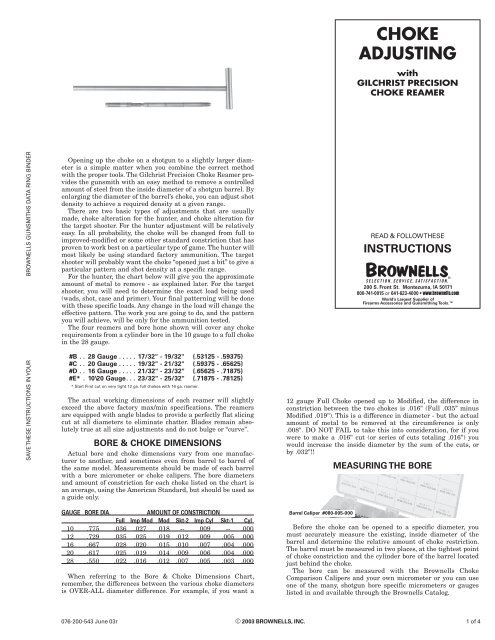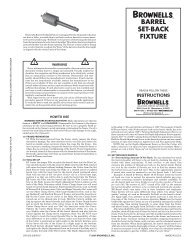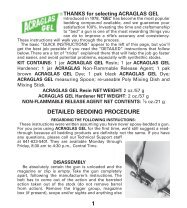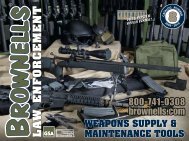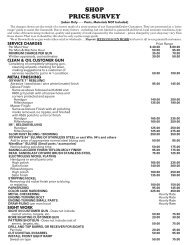You also want an ePaper? Increase the reach of your titles
YUMPU automatically turns print PDFs into web optimized ePapers that Google loves.
SAVE THESE INSTRUCTIONS IN YOUR BROWNELLS GUNSMITHS DATA RING BINDER<br />
Opening up the choke on a shotgun to a slightly larger diameter<br />
is a simple matter when you combine the correct method<br />
with the proper tools. The Gilchrist Precision Choke Reamer provides<br />
the gunsmith with an easy method to remove a controlled<br />
amount of steel from the inside diameter of a shotgun barrel. By<br />
enlarging the diameter of the barrel’s choke, you can adjust shot<br />
density to achieve a required density at a given range.<br />
There are two basic types of adjustments that are usually<br />
made, choke alteration for the hunter, and choke alteration for<br />
the target shooter. For the hunter adjustment will be relatively<br />
easy. In all probability, the choke will be changed from full to<br />
improved-modified or some other standard constriction that has<br />
proven to work best on a particular type of game. The hunter will<br />
most likely be using standard factory ammunition. The target<br />
shooter will probably want the choke “opened just a bit” to give a<br />
particular pattern and shot density at a specific range.<br />
For the hunter, the chart below will give you the approximate<br />
amount of metal to remove - as explained later. For the target<br />
shooter, you will need to determine the exact load being used<br />
(wads, shot, case and primer). Your final patterning will be done<br />
with these specific loads. Any change in the load will change the<br />
effective pattern. The work you are going to do, and the pattern<br />
you will achieve, will be only for the ammunition tested.<br />
The four reamers and bore hone shown will cover any choke<br />
requirements from a cylinder bore in the 10 gauge to a full choke<br />
in the 28 gauge.<br />
#B . . 28 Gauge . . . . . 17/32" - 19/32" (.53125 - .59375)<br />
#C . . 20 Gauge . . . . . 19/32" - 21/32" (.59375 - .65625)<br />
#D . . 16 Gauge . . . . . 21/32" - 23/32" (.65625 - .71875)<br />
#E* . 10\20 Gauge . . . 23/32" - 25/32" (.71875 - .78125)<br />
* Start First cut on very tight 12 ga. full chokes with 16 ga. reamer.<br />
The actual working dimensions of each reamer will slightly<br />
exceed the above factory max/min specifications. The reamers<br />
are equipped with angle blades to provide a perfectly flat slicing<br />
cut at all diameters to eliminate chatter. Blades remain absolutely<br />
true at all size adjustments and do not bulge or “curve”.<br />
BORE & <strong>CHOKE</strong> DIMENSIONS<br />
Actual bore and choke dimensions vary from one manufacturer<br />
to another, and sometimes even from barrel to barrel of<br />
the same model. Measurements should be made of each barrel<br />
with a bore micrometer or choke calipers. The bore diameters<br />
and amount of constriction for each choke listed on the chart is<br />
an average, using the American Standard, but should be used as<br />
a guide only.<br />
GAUGE BORE DIA. AMOUNT OF CONSTRICTION<br />
Full Imp Mod Mod Skt-2 Imp Cyl Skt-1 Cyl<br />
10 .775 .036 .027 .018 -- .009 -- .000<br />
12 .729 .035 .025 .019 .012 .009 .005 .000<br />
16 .667 .028 .020 .015 .010 .007 .004 .000<br />
20 .617 .025 .019 .014 .009 .006 .004 .000<br />
28 .550 .022 .016 .012 .007 .005 .003 .000<br />
When referring to the Bore & Choke Dimensions Chart,<br />
remember, the differences between the various choke diameters<br />
is OVER-ALL diameter difference. For example, if you want a<br />
<strong>CHOKE</strong><br />
<strong>ADJUSTING</strong><br />
with<br />
GILCHRIST PRECISION<br />
<strong>CHOKE</strong> REAMER<br />
READ & FOLLOWTHESE<br />
INSTRUCTIONS<br />
12 gauge Full Choke opened up to Modified, the difference in<br />
constriction between the two chokes is .016" (Full .035” minus<br />
Modified .019"). This is a difference in diameter - but the actual<br />
amount of metal to be removed at the circumference is only<br />
.008". DO NOT FAIL to take this into consideration, for if you<br />
were to make a .016" cut (or series of cuts totaling .016") you<br />
would increase the inside diameter by the sum of the cuts, or<br />
by .032"!!<br />
Barrel Caliper #080-005-000<br />
200 S. Front St. Montezuma, IA 50171<br />
800-741-0015 or 641-623-4000 • www.brownells.com<br />
World’s Largest Supplier of<br />
Firearms Accessories and Gunsmithing Tools.<br />
MEASURING THE BORE<br />
Before the choke can be opened to a specific diameter, you<br />
must accurately measure the existing, inside diameter of the<br />
barrel and determine the relative amount of choke restriction.<br />
The barrel must be measured in two places, at the tightest point<br />
of choke constriction and the cylinder bore of the barrel located<br />
just behind the choke.<br />
The bore can be measured with the <strong>Brownells</strong> Choke<br />
Comparison Calipers and your own micrometer or you can use<br />
one of the many, shotgun bore specific micrometers or gauges<br />
listed in and available through the <strong>Brownells</strong> Catalog.<br />
076-200-543 June 03r © 2003 BROWNELLS, INC. 1 of 4
To measure the inside diameter of a shotgun barrel, first<br />
clamp the barrel in a padded bench vise. Insert the bore gauge<br />
or micrometer into the bore and determine the smallest inside<br />
diameter of the choke section of the barrel. Move the micrometer<br />
or gauge down the bore to the cylinder bored portion of the barrel<br />
located just behind the choke and get a reading of the diameter.<br />
It should be larger in diameter than the choke section.<br />
Subtract the first measurement from the second measurement<br />
and refer to the chart on page 1 to determine the relative amount<br />
of choke restriction. Please remember that this method and chart<br />
will only determine the relative amount of choke restriction<br />
Actual choke restriction can only be determined by patterning<br />
the shotgun with the type of ammunition that will be used.<br />
DOING <strong>CHOKE</strong> ADJUSTMENT WITH THE<br />
GILCHRIST PRECISION <strong>CHOKE</strong> REAMER<br />
The handle and extension consist of two pieces. The extension<br />
shaft threads onto the rear of the cutter shank and the<br />
T-handle threads onto the rear of the extension shaft. The fit<br />
of the threaded section is loose, and this is deliberate. A loose<br />
thread fit prevents the cutters from being rotated in a counterclockwise<br />
direction. This can cause serious damage to the cutters,<br />
and the choke inside the barrel. DO NOT ALTER THE FIT OF<br />
THE T-HANDLE OR THE EXTENSION SHAFT, OR ATTEMPT<br />
TO ROTATE THE CUTTERS IN A COUNTER-CLOCKWISE<br />
DIRECTION. This is a manual tool; DO NOT APPLY POWER.<br />
Choke Reamer shown with Clymer Choke<br />
Tooling Bushings & C-Clips in place.<br />
Clymer Choke Tooling Bushings are used to pilot the cutter<br />
shaft. Bushings are selected to the nearest .001" under bore size.<br />
This size is best determined by using a shotgun barrel gauge. For<br />
accurate readings, make sure the barrel is CLEAN AND FREE<br />
of powder, lead and plastic fouling. Two bushings, both the same<br />
size, are required to properly align the cutter shaft with the bore<br />
of the barrel. To install the bushing on the shaft, first unscrew<br />
the cutter head, remove three of the C-clips, and place the bushing<br />
on the shaft. Replace two of the C-clips then slip the second<br />
bushing into the shaft. Install the last C-clip to hold the second<br />
bushing in place. The bushings should now be secured on the<br />
shaft with a space of 2.15" between them.<br />
NOTE: If the bushings do not move freely in the bore, apply<br />
a light coat of oil in the barrel for the pilot bushings to ride on.<br />
Lubrication may help smooth the hand feed. Otherwise, go to the<br />
next smaller size bushing.<br />
The barrel should be removed from the action before altering<br />
the choke. Secure the barrel vertically in a padded vise, muzzle<br />
toward the floor and approximately waist high. In addition to the<br />
reamer and handle assembly you will need: dark cutting oil (Do-<br />
Drill will work fine), a cleaning rod and plenty of shotgun-sized<br />
cleaning patches. A small can or bucket on the floor under the<br />
barrel will help catch the excess oil and used patches.<br />
Select the appropriate reamer. Adjust the reamer to minimum<br />
diameter. Pour a small amount of cutting oil on the cutters and<br />
insert them down from the breech end, toward the muzzle of the<br />
barrel. Align the pilot bushings in the bore and slowly rotate the<br />
cutter handle in a clockwise direction until the cutting blades<br />
contact the choke portion of the barrel.<br />
DO NOT STRIKE THE INSIDE OF THE BARREL AND<br />
CHAMBER WITH THE CUTTERS WHILE THE PILOTS ARE<br />
NOT ENGAGED AND CENTERING THE SHAFT!<br />
If the angle blade reamer goes all the way thru the bore without<br />
touching the sides, remove the tool and adjust the cutters to<br />
a slightly larger diameter (.003-.005"). This is done by backing<br />
off on the rear adjusting nut (the one toward the handle) one half<br />
turn maximum, and tightening the front adjusting nut (the one<br />
toward the front end of the cutter). This pushes the blades to the<br />
rear and up the inclined cuts to enlarge the overall diameter of<br />
the reamer. An angle Blade Reamer is tapered. The small end<br />
of the reamer is in front. It guides the reamer gently into the<br />
choke portion of the bore and enhances alignment with the bore<br />
and choke.<br />
Adjust the reamer a small amount at a time until it just touches<br />
the sides of the choke. Apply more cutting oil and make the<br />
first cut. Rotate the cutter handle in a clockwise direction. Allow<br />
the weight of the reamer and handle to apply the pressure. When<br />
the reamer has cut its full length, continue rotating it in the<br />
same direction, and withdraw the reamer back up the barrel.<br />
Brush the chips from the reamer and clean the barrel with a<br />
tight fitting patch. Measure the choke. Repeat the procedure if<br />
additional metal must be removed. There is a flat on the adjusting<br />
nuts that can be used as a scale (see illustration). Position<br />
this flat between two of the blades and make a cut. Remove the<br />
reamer and rotate the nut to a position between the next two<br />
blades. The second cut will remove .002" from the DIAMETER of<br />
the choke.<br />
HONING<br />
No. 2 Barrel Hone #531-108-002<br />
The final .001" should be removed with the hone. The honing<br />
stones are pressed against the sides of the choke by the coil<br />
spring and the pressure should be firm at all times to prevent<br />
chatter. The flexible shaft assures correct alignment with the<br />
bore. The hone can be rotated in several ways but a regular<br />
electric hand drill is all that is necessary. Insert the hone in the<br />
choke and turn the drill on. Move the hone in and out for fifteen<br />
seconds with plenty of cutting oil in the barrel. ALWAYS turn<br />
the drill OFF before removing the hone. Wipe the bore clean and<br />
inspect. The barrel should be smooth and free of all scratches.<br />
REAMER CARE<br />
The cutting edge of angle blade reamers should be lightly<br />
honed for best performance. Arkansas stones and thin India<br />
stones should be used for sharpening. The best way to keep them<br />
clean and sharp is to keep them oiled and wrapped at all times<br />
when not in use. Do NOT knock chips out of reamer on edge of<br />
bench or on block of wood. Carefully brush reamers to remove<br />
chips.<br />
NEVER turn a reamer counter-clockwise as you remove it from<br />
a barrel. Always keep turning in the same direction until the<br />
reamer is completely removed from the barrel. DO NOT take<br />
a big cut at one time with Angle Blade Reamers. Never make a<br />
cut larger than .003" and preferably less. ALWAYS release the<br />
tension on your Angle Blade Reamers when not in use. In COLD<br />
WEATHER Angle Blade Reamers should be warmed before<br />
exerting extreme setting pressure to prevent possible fracture<br />
of blades.<br />
CHROME-LINED BARRELS<br />
These reamers will not cut chrome-lined barrels. Any attempt<br />
to do so will ruin the reamer and void the guarantee. To determine<br />
if a barrel is chrome-lined, touch a drop of Oxpho-Blue or<br />
other good cold blue to the inside of the muzzle. If it blues or<br />
stains, it is not chrome-lined, and is okay to work on.<br />
Gunsmith customers have advised us they have removed<br />
the chrome-lining by careful honing and copious flooding with<br />
cutting oil prior to normal choke adjustment with satisfactory<br />
results. This can be a tricky operation depending upon the<br />
thickness/uniformity/hardness of chrome, and should only be<br />
undertaken with caution and an intimate knowledge of what is<br />
required.<br />
2 of 4 © 2003 BROWNELLS, INC. 076-200-543 June 03r<br />
➘<br />
Arrow shows flat on adjustment nut
REVERSE OR “JUG” <strong>CHOKE</strong>S<br />
Reverse or “Jug” type Chokes are occasionally found in shot-<br />
guns. The choke effect is obtained in Reverse Choking by the<br />
removal of metal from the bore, starting a short distance behind<br />
REAMER SHARPENING INSTRUCTIONS<br />
As with any precision tool, you should be very careful in the use and maintenance<br />
of this reamer. Always observe the following guidelines:<br />
1. NEVER back off or turn the reamer in a COUNTER-CLOCKWISE direction.<br />
When removing the reamer from the workpiece, continue to turn<br />
it in a clockwise direction<br />
2. NEVER use this reamer in a chrome or nickel-plated bore.<br />
3. Always use a good cutting oil such as Do-Drill and frequently clear<br />
the chips from the reamer during use.<br />
4. NEVER try to cut more than .003" in one pass when using an adjustable<br />
reamer. Cutting too much is a major cause of “chatter”.<br />
5. During use, keep the reamers clean and well oiled. Ensure that there<br />
are no chips under the blades of the adjustable reamers.<br />
6. Stone the FACE of the blades when sharpening reamers; refer to<br />
Drawings #1 and #2. Do NOT stone or “sharpen” the TOP of the blades.<br />
Doing so VOIDS all guarantees/warranties.<br />
7. Clean and oil reamers after use and store in individual plastic tubing or<br />
boxes to protect the blades from chipping or breakage.<br />
8. Reamers should always be treated with the same care as given a precision<br />
micrometer or caliper. The more careful you are, the longer your reamer<br />
will last!<br />
If you have any problems or questions relating to your reamers, don’t hesitate<br />
to call. Our technical staff is available to help Monday through Friday<br />
from 8:30 am to 4:30 pm Central time.<br />
the muzzle and extending down the barrel toward the breech. On<br />
a 12 gauge, for example, the recess may be from 10" to 12" long<br />
and about .015" deep for modified choke and .021" deep for full<br />
choke. You can readily see from this that you cannot “Open Up”<br />
a choke such as this by making the recess deeper. Doing so would<br />
tighten the choke! Opening the pattern on such a gun can only<br />
be achieved by very carefully honing the short stretch of barrel<br />
between muzzle and choke recess. Repeated test-firings should<br />
be made during this type of adjustment to be sure too much<br />
metal is not removed and is opened up.<br />
DRAWING #1<br />
BLADE FOR ANGLE<br />
BLADE REAMERS<br />
STONE FACE OF BLADE<br />
ONLY ON FLAT<br />
SHARPENING STONE<br />
SHARPENING<br />
STONE<br />
DRAWING #2<br />
LONG FORCING<br />
CONE REAMER<br />
076-200-543 June 03r © 2003 BROWNELLS, INC. 3 of 4<br />
TOP OF<br />
BLADE<br />
BLADE<br />
FACE OF<br />
BLADE<br />
FACE OF<br />
BLADE<br />
CORRECT<br />
(Face being<br />
stoned)<br />
REAMER<br />
INCORRECT<br />
(Top being<br />
stoned)<br />
TOP OF<br />
BLADE<br />
SHARPENING<br />
STONE
200 S. Front St. Montezuma, IA 50171<br />
800-741-0015 or 641-623-4000 • www.brownells.com<br />
World’s Largest Supplier of<br />
Firearms Accessories and Gunsmithing Tools.<br />
4 of 4 © 2003 BROWNELLS, INC. 076-200-543 June 03r


